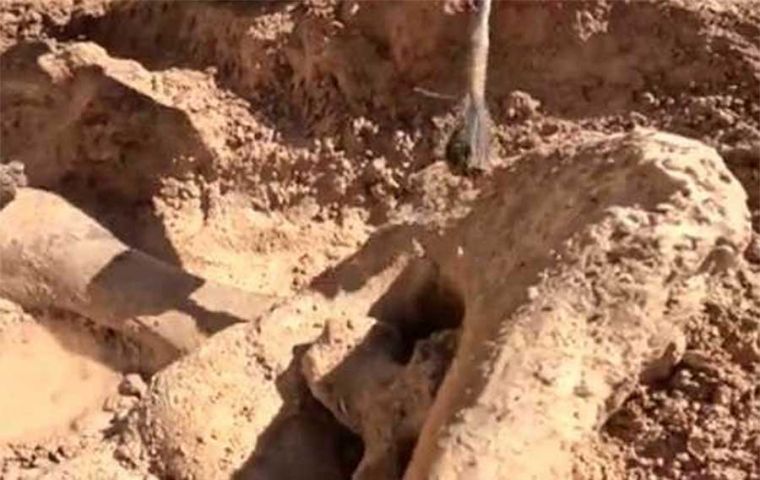MercoPress. South Atlantic News Agency
Well-preserved Ice Age mastodons found in Peru
 The near-complete preservation of one specimen heralded possible findings of global importance if the skull is found, it was explained
The near-complete preservation of one specimen heralded possible findings of global importance if the skull is found, it was explained Peruvian archaeologists found the fossilized remains of three Ice Age mastodons, which shed new light on these animals' presence in the region, with further specimes hoped to be unearthed shortly as the excavations that began in 2019 in the Chambara Valley, 300 kilometers east of Lima, are scheduled to continue. The behemoths found there are believed to be between 11,000 and 12,000 years old.
The experts believe that the mastodons migrated from North America to South America seeking food and water as climate conditions changed. The Andes rose over time, receding sea water and creating lagoons across the Mantaro Valley. Peru's rich prehistoric record includes a recently discovered ancient river dolphin skull deemed as belonging to an animal that swam through the Peruvian Amazon some 16 million years ago.
Paleontologist Ivan Meza highlighted the near-complete preservation of one specimen, hoping to find its skull and tusks, which could result in global importance in this particular scientific field. “If the skull is found - and everything indicates that the tusks are there - that would have scientific importance at a national and global scale,” he underlined. Mastodons were similar to the also-extinct mammoth but had flatter heads and straighter tusks.
“We're talking about a small area of less than one hectare,” Meza said. “To date, we've discovered three specimens, with the possibility of there being more, and from other types of animals,” he went on.
“Over time, the Andes mountain range rose and the sea water receded,” explained Engineer Oscar Díaz. “This area dried up and left lagoons across the Mantaro Valley,” which would have provided a source of water, added the mastodon expert.
In a separate development, Peru's Culture Ministry took delivery this week of some 74 archaeological items brought back from the United States, including artifacts and paintings. According to a press release from Lima's Foreign Ministry, there were 68 archeological pieces consisting of ceramics, textiles, lithic, metals, a wooden vase, and instruments made by native peoples of the Paracas, Nasca, Cajamarca, Lambayeque, and other cultures from animal bones between 2000 and 500 years ago.
Of these pieces, 57 were returned voluntarily by individuals, and 11 others were seized by a US Homeland Security investigation. Other historic items were a manuscript contract of one of the first theater companies of America in the 16th century, signed by eight comedians residing in Callao, which was stolen and became part of the Rosenbach Museum and Library in the 1920s before being retrieved by the Federal Bureau of Investigation (FBI) last year. It was returned to Peru via the Foreign Ministry in March this year and only this week was it handed over to cultural authorities.
In addition, two 17th-century paintings were featured in the lot delivered to the Culture Ministry. They had been stolen in Cusco in 2008 before they were put out on the black market, where the FBI rescued them thanks to supporting documentation supplied by the Peruvian government. Deputy Foreign Minister Peter Camino underlined that these restitutions had been possible thanks to the “close international cooperation, collaboration and exchange of experiences.”




Top Comments
Disclaimer & comment rulesCommenting for this story is now closed.
If you have a Facebook account, become a fan and comment on our Facebook Page!